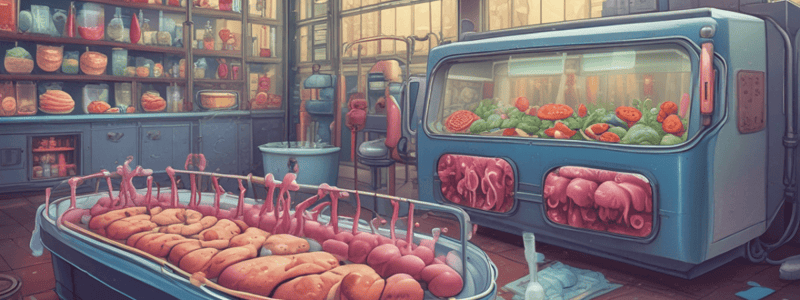Podcast
Questions and Answers
Which of the following culture samples is collected for diagnosing gastroenteritis?
Which of the following culture samples is collected for diagnosing gastroenteritis?
- Amniotic fluid culture
- Stool culture (correct)
- Blood culture
- Cerebrospinal fluid (CSF) culture
What is the characteristic of Clostridium bacteria?
What is the characteristic of Clostridium bacteria?
- Gram-positive, motile and obligate anaerobes (correct)
- Gram-negative, straight or curved rods
- Non-motile, facultative anaerobes with catalase activity
- Motile, obligate aerobes with catalase activity
What is the appropriate treatment for disseminated Listeriosis?
What is the appropriate treatment for disseminated Listeriosis?
- Supportive care with hydration and rest
- Intravenous ampicillin combined with gentamicin (correct)
- Meropenem only for those with contraindications to ampicillin
- Ultrasound or CT scan to identify liver abscesses
What is the characteristic of Clostridium spores?
What is the characteristic of Clostridium spores?
What is the characteristic of Clostridium perfringens?
What is the characteristic of Clostridium perfringens?
What is the function of exotoxins produced by Clostridium bacteria?
What is the function of exotoxins produced by Clostridium bacteria?
What is a common symptom of Clostridium perfringens foodborne illness?
What is a common symptom of Clostridium perfringens foodborne illness?
How does Clostridium perfringens enterotoxin (CPE) affect intestinal epithelial cells?
How does Clostridium perfringens enterotoxin (CPE) affect intestinal epithelial cells?
What is the minimum temperature required to inactivate Clostridium perfringens enterotoxin (CPE)?
What is the minimum temperature required to inactivate Clostridium perfringens enterotoxin (CPE)?
What is a common source of Clostridium perfringens infection in wounds?
What is a common source of Clostridium perfringens infection in wounds?
What is a characteristic symptom of clostridial myonecrosis (gas gangrene)?
What is a characteristic symptom of clostridial myonecrosis (gas gangrene)?
What is the primary treatment for Clostridium perfringens foodborne illness?
What is the primary treatment for Clostridium perfringens foodborne illness?
What is the purpose of anaerobic tissue culture in diagnosing Clostridium perfringens infection?
What is the purpose of anaerobic tissue culture in diagnosing Clostridium perfringens infection?
What is the primary treatment for clostridial myonecrosis?
What is the primary treatment for clostridial myonecrosis?
What is the primary mode of transmission of Clostridium difficile?
What is the primary mode of transmission of Clostridium difficile?
What is the role of Toxin A in the pathogenesis of C.difficile?
What is the role of Toxin A in the pathogenesis of C.difficile?
What is a common symptom of C.difficile infection?
What is a common symptom of C.difficile infection?
What is a complication of C.difficile infection?
What is a complication of C.difficile infection?
What is the typical Gram stain appearance of C.difficile?
What is the typical Gram stain appearance of C.difficile?
What is a risk factor for C.difficile infection?
What is a risk factor for C.difficile infection?
What is the primary treatment for C.difficile infection?
What is the primary treatment for C.difficile infection?
What is the characteristic of C.difficile infection that distinguishes it from cholera?
What is the characteristic of C.difficile infection that distinguishes it from cholera?
Flashcards are hidden until you start studying
Study Notes
Diagnosis of Listeriosis
- Culture samples are used to diagnose Listeriosis, depending on symptoms:
- Stool culture for gastroenteritis
- Blood culture for bacteremia
- Cerebrospinal fluid (CSF) culture for meningitis
- Amniotic fluid culture for trans-placental infection
- Imaging studies like ultrasound or CT scan can identify liver abscesses
Treatment of Listeriosis
- Gastrointestinal Listeriosis: Supportive care (hydration, rest) is used
- Disseminated Listeriosis: Intravenous ampicillin combined with gentamicin is used
- Alternatives: Meropenem is used for those with contraindications to ampicillin (e.g., pregnant individuals, those allergic to ampicillin)
Clostridium Bacteria
- General characteristics:
- Gram-positive, may appear Gram-negative in older cultures
- Straight or curved rods, may appear singly, in pairs, or in chains
- Spore former, with endospores
- Motile, with peritrichous flagella (except C. ramosum and C. innocuum)
- Non-encapsulated (except C. perfringens)
- Obligate anaerobes, strict anaerobes
- Catalase-negative
- Virulence factors:
- Exotoxins, varied among species
- C. perfringens has type A, B, C, D, E toxins
Clostridium difficile
- Growth and laboratory identification:
- Gram-positive, appearing purple and rod-shaped under the microscope
- Colonization and infection:
- Fecal-oral route, typically acquired through ingestion of bacteria from fecal matter
- Asymptomatic carriers, about 5% of the population
- Disturbance of gut flora, allowing C. difficile overgrowth
- Pathogenic mechanism:
- Toxin production, main pathogenic mechanism
- Toxin A (TCDA), a potent enterotoxin
- Toxin B (TCDB), a cytotoxin
- Symptoms and complications:
- Diarrhea, abdominal pain, and high fever
- Severe complications, such as toxic megacolon, intestinal rupture, septic shock, and death if untreated
Foodborne Illness
- Common cause, often called the "cafeteria germ"
- Contamination, spores can contaminate food left out for a while
- Toxin production, produces Clostridium perfringens enterotoxin (CPE) within 24 hours of colonization
- Heat sensitivity, CPE is heat-labile and can be inactivated by cooking at 72°C or above
- Symptoms, abdominal cramping, watery diarrhea, and vomiting
- Symptoms typically improve within a day without the need for antibiotics, hydration is the primary treatment
Wound Infections
- Introduction to wounds, can infect wounds made by dirty, sharp objects in contact with soil
- Myonecrosis, causes clostridial myonecrosis (gas gangrene) via Clostridium perfringens alpha-toxin (CPAT)
- Symptoms, extreme pain, swelling, thin watery pus, blood-filled bullae, and crepitus (crackling sound of gas in tissue)
- Pathogenesis and symptoms of myonecrosis:
- Cell death, causes necrosis (uncontrolled cell death)
- Progression, rapidly progresses to fever, tachycardia, hypotension, shock, and potentially death within hours if untreated
Studying That Suits You
Use AI to generate personalized quizzes and flashcards to suit your learning preferences.



